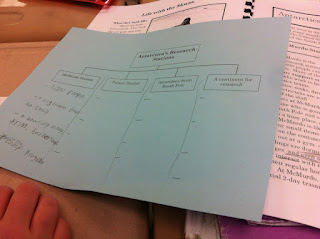Kids have to be able to find topics and main ideas to understand nonfiction text. I look at these lessons as the foundation for all of our nonfiction work in the months to come. This week, I worked on topics and main ideas with several different groups of readers. Here are some thoughts on my experiences.
Do not: Assume that students already know how to find topics and main ideas in text
I've been teaching about this for more than a decade. Many kids are masters of skimming by when it comes to topic and main idea. They've learned to read the teacher, looking for the clues that you are subconsciously giving, instead of reading the text. I often resort to pretending that the text has a different topic to avoid giving these clues. Then the students have to convince me what the topic is!
Do: Look for repeated references in a text
To the adult reader, the topic of the text above just jumps right out: Weddell seals! But younger readers who are still reading word-for-word often do not take in the "whole view" of the text. For these readers, it's important to show them how to underline the repeated words in the text. We found every example of Weddell seal in the text above. As we did this, students saw quickly what the topic was.
Do: Look for multiple referents
Some texts, though, are tricky. Consider the text to the right. The topic, Southern elephant seals, is only mentioned once. The seals are referred to with the pronoun they and the referent these seals. Teaching topics with struggling readers is the perfect time to address multiple referents.
What did one of the readers suggest as the topic of this paragraph? Think about the way that struggling readers scan for words that they know. Yup--she said this paragraph was about elephants. On the one hand, this is a discouraging answer. On the other hand, it shows that she is trying to scan for a topic. She just needs more practice with going back to the text to refine her hypothesis.
Do: Have students work in pairs
Pairing students up to talk about their thinking is a great way to find out misconceptions. It's also a great way to find out new thinking tricks! My on- and above-grade level readers worked to sort cut-apart paragraphs. They had to read each sentence, and then determine the topic and the main idea. Listening in on the conversations was a fantastic way for me to hear what readers were thinking. For example, one pair was discarding the actual main idea sentences because they didn't sound "interesting" enough. (Main ideas often do sound boring, don't they? It's the details that are interesting.) This was a whole new way of looking at the task. I acknowledged their thinking, and then explained that main ideas often do sound boring. This helped them as they worked on their next paragraph.
In another group, I overheard a brilliant reader talking offhandedly as she sorted cards: "Detail, detail, detail, detail." When I asked her what she was doing, she said, "Well, first I just find the sentences that sound detail-y, the ones that have numbers and stuff. Those aren't going to be the main idea, so I set them aside." Again, this provided me with some insight about how students go about the task, and some good student language to use when helping struggling readers.
Do: Take it right back to text
I like to think of nonfiction instruction as following a whole-part-whole model. We look at a text and read it for an initial understanding. Then we look at a part--in this case, topics and main ideas. The next step is to take the idea back to the text.
For my struggling readers, I went right back to the familiar "Welcome to Antarctica" text that we had already read. We looked at the paragraphs and applied the same strategies to finding the topics and main ideas. Doing this with familiar text was helpful for them, as they could focus on the task instead of gaining an initial understanding.
For the other group of readers, we went right on to a new text, with the students applying the idea of topic and main idea to their work on a note-taking sheet. These readers thrive on novelty, so the challenge of a new text and a new concept really engaged them.
This is the first year that I have managed to pull together completely "united" activities, in that everything goes back to the Antarctica topic study we are doing this month. And I love it. The card match activity, the topics and main ideas paragraphs, and our core texts all reinforce one another, leading to great questions and use of vocabulary.
Additional Resources
Finding Topics and Main Ideas: Free Powerpoint from TeachersPayTeachers. (Note: My husband uses this, and always complains about the template that I used...one of these days I'll fix it up! The texts are good, and the sequence of instruction.)
Main Ideas and Details in Nonfiction Text: The Antarctica paragraphs are in here, along with many other items about supporting main ideas. A non-Antarctica version of the sorting sentences is included. (I'll get around to posting all of the Antarctica stuff eventually.)
Summarizing, Paraphrasing, and Retelling: I learned a great deal about main ideas and topics as I researched this book. You'll find more on implicit main ideas, as well as research on how readers process main ideas.





No comments:
Post a Comment